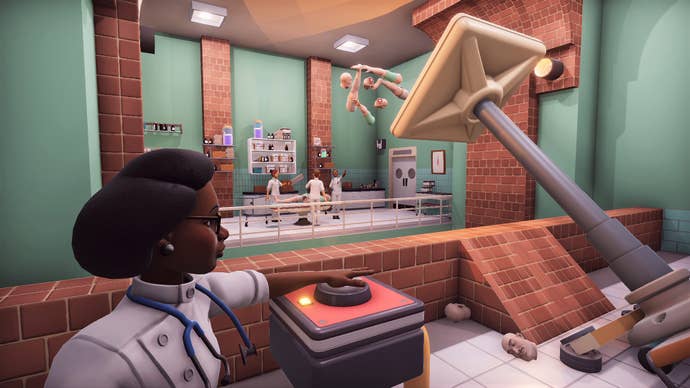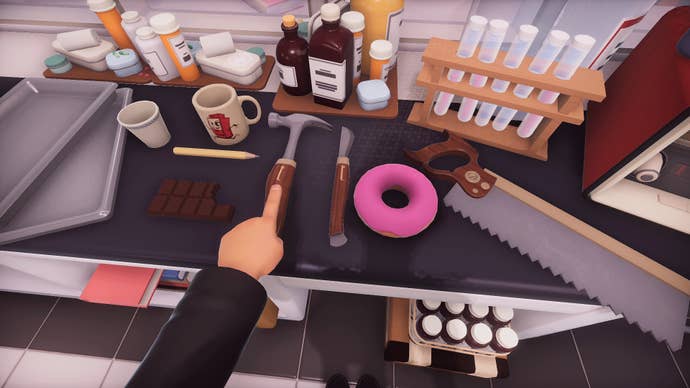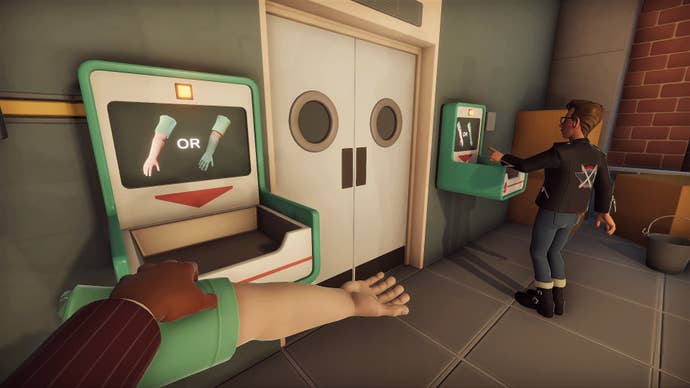How Surgeon Simulator 2 Is Trying to Be More Than a Medical Mayhem Machine
Bossa's building this sequel with co-op, puzzles, and user-created content in mind.
This article first appeared on USgamer, a partner publication of VG247. Some content, such as this article, has been migrated to VG247 for posterity after USgamer's closure - but it has not been edited or further vetted by the VG247 team.
Surgeon Simulator 2 is not what I expected it to be. It dodged my earliest preconceptions as soon as I loaded it up and realized that WASD let me walk around a room. Bossa Studios' sequel, announced at last year's Game Awards, is a multiplayer take on the madcap malpractice from Surgeon Simulator 2013. That was hinted at before, but the full extent of Bossa's ambitions with Surgeon Sim 2 is clearer now: following in the co-op steps of titles like Portal 2 and aiming for the user creation freedoms of, say, a LittleBigPlanet, Surgeon Simulator 2 wants to let you and your friends flail around in whatever bizarre surgery-adjacent scenario you can dream up.
Playing through a guided demo with Senior Producer Marc Pick and Senior Game Designer Nate Gallardo, I had the chance to ask about exactly what motivated a return to Bossa's breakout series seven years later, and to dissect why and how the studio is taking the sequel in such a different direction. First, though, we had some surgeries to do.
Although Surgeon Simulator 2 lets players walk, run, jump, and crouch with real first-person control this time, Bossa hasn't strayed too far from the blunder-inducing inputs it pioneered. Players control the actions of one arm stuck out in front of them, using a combination of keys to extend it, rotate at the joints, and ineptly grab tools and other physics props. "In most first-person games you play an insanely competent person, and you can carry 50 guns around with you somehow, leap tall buildings, kill 1,000 dudes without even breaking a sweat," says Gallardo. "And then, our game is the complete other end of the scale, where just picking up a suitcase and holding it, that in itself is an accomplishment."

So, unburdened by the pressure to be a games journalist with instantly transferable skills, myself, Gallardo, Pick, and our fourth physician Nick Marshall, Bossa PR, made our way through some early tutorial levels and other surgery challenges. Between bits where we were actually removing rib cages or popping off limbs, there was a lot of puzzle-solving and exploration to do.
Those segments both feel unlike Surgeon Simulator and yet never stray far from the series' premise. In fact, it felt like we were looking for necessary tools and organs as much as we were also tasked with using our patient Bob's body parts in order to progress forward. Only a warped series like Surgeon Simulator (okay, and Doom) would ask players to casually yoink a severed limb to unlock a door.
Most of Surgeon Simulator 2 will be playable with one-to-four players, and Bossa is crafting a story mode this time around that players can complete alone or together. The story missions we played didn't have the story voiceover yet—that said, I definitely got the sense while exploring this sprawling, strange hospital, that Bossa's taking cues from other first-person puzzlers like Portal or The Talos Principle, albeit with mechanics and opportunities for messing around that have more in common with Garry's Mod.
"Bossa does a lot of R&D and tech research alongside the games we ship, and we always wanted to do multiplayer surgery," Pick says, explaining how Bossa arrived at this direction for a sequel. "That was always this kind of vision the studio had from the very top. It's this game that's so fun to watch other people play. Why would you not recreate that in real time in front of your very eyes?"

Surgeon Simulator 2013, initially dreamed up during a game jam, became a huge hit amongst YouTube content creators like Jacksepticeye. At the top end, those folks can command millions of views no matter what game they play, but the hijinks inherent to Surgeon Simulator gave it a more surefire, universal appeal. Not losing that aspect, while also adding in multiplayer and user creation, is the trick Bossa's been working out for two and a half years and with the help of scores of playtesters.
"For me, one of the things that was most exciting about the idea of working on the game was the sort of performative element of it," Gallardo says. "All these people, all these streamers and YouTubers, were using [Surgeon Simulator 2013] very much as a platform. It was a stage on which they could express themselves, and they could really bring something of their own style and their own performative elements to it.
"It's all about just creating a space in which players can express themselves, which they can play in a very pure sense. It's one thing to just complete levels and objectives, it's another to just give players the tools and toys to create their own fun while they happen to be there."
Asking Gallardo about how the goal of preserving that room for expression is being balanced against making a co-op experience that won't simply collapse into slapstick and/or frustration, I got a thorough and thoughtful answer back. Gallardo is personally into designing things diegetically, and this runs throughout Surgeon Sim 2. In regular play, information is displayed on diagnostic screens and other stuff around the environment, not a menu or HUD. When it comes to seeing or signaling other players, there won't be outlines through walls or a pinging system. Players can manually wave an arm around, hold up a certain number of fingers, snap for attention, dance awkwardly—and yes, there will be text chat—but Bossa seems to draw the line at systems that might make you too competent, keeping things in Surgeon Simulator's sweet spot.

It's unclear just how much that will extend to Surgeon Simulator 2's Creation Mode, which Bossa didn't show off in our demo, but Gallardo and Pick were happy to discuss. Story voiceover aside, they say, all the official levels Bossa has crafted for Surgeon Simulator 2 have been made using the Creation Mode tools. The tools will also work with up to four players and can be toggled on or off for quick iteration, testing, and play.
It'll also include a logic system inspired by node-based editors that creators can use to make new gameplay and modes within Surgeon Simulator 2. Pick says users have already made "levels which are a little bit like Overcooked, where you've got a two-minute countdown and random Bobs are going to spawn, and you've got to do as many surgeries as you can in the time you've got." It's not all limited to co-op, either: there's a competitive basketball creation out there, featuring Bob's head as the ball, that actually counts points up as teams play.
Gallardo and Pick say it's been fun for Bossa to load up Surgeon Sim 2 as a team after work, have some beers, and play through new levels made by playtesters. Obviously, investing in user-made content tools is another way to capitalize on the success with streamers of the original Surgeon Simulator, but may also make folks who like to tinker away in solitude very happy. I'm a bit of a sucker for that kind of thing, but I'm still something of a skeptic: as neat as the freedoms of games like Dreams or Super Mario Maker are, and as smart as it seems Bossa is being, it's hard to nail the way tools work or how user content is surfaced.
To Surgeon Simulator 2's benefit, however, goofball surgery still has comedic legs. People will get a chance to see how Bossa did marrying that with its newer, grander ambitions, when Surgeon Simulator 2 launches on the Epic Games Store later this year.


